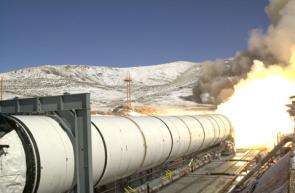A two-minute static firing of a space shuttle technical evaluation motor was successfully completed March 9 at ATK Thiokol, a unit of Alliant Techsystems, Inc., in Promontory, Utah, north of Salt Lake City. The test included 26 specific objectives and used 89 instrumentation channels to collect and evaluate motor performance. Results will be published in a final report later this year. (ATK Thiokol)
NASA's Space Shuttle Program successfully fired a full-scale, full-duration reusable solid rocket technical evaluation motor Thursday, March 9, at a Utah test facility. The two-minute static, or stationary, firing of the rocket motor was performed at ATK Thiokol, a unit of Alliant Techsystems Inc., in Promontory, north of Salt Lake City.
The technical evaluation motor, or TEM-12, burned for approximately 123 seconds, the same duration each reusable solid rocket motor burns during an actual space shuttle launch. The static-fire test included 26 specific objectives and used 89 instrumentation channels to collect and evaluate the motor’s performance.
Preliminary data indicates that all test objectives were met. After final test data are analyzed, results for each objective will be published in a final report which will be available later this year.
"Test results will provide engineers unique information about motor components that have been exposed to the environment in Florida at the Kennedy Space Center," said Jody Singer, manager of the Reusable Solid Rocket Motor Project, part of the Space Shuttle Propulsion Office at NASA's Marshall Space Flight Center in Huntsville, Ala. "Testing such as this is important to ensure continued quality and performance."
The shuttle's reusable solid rocket motor is the largest solid rocket motor ever flown, the only one rated for human flight and the first designed for reuse. Each shuttle launch requires the boost of two reusable solid rocket motors to lift the 4.5-million-pound shuttle vehicle. During space shuttle flights, solid rocket motors provide 80 percent of the thrust during the first two minutes of flight. Each motor generates an average thrust of 2.6 million pounds and is just over 126 feet long and 12 feet in diameter. It is the primary component of the shuttle's twin solid rocket boosters.
During a shuttle launch, the solid propellant rockets take the shuttle to an altitude of 28 miles at a speed of 3,094 mph before they separate and fall into the ocean to be retrieved, then refurbished and prepared for another flight.
Regular static-fire tests of the motors help maintain the highest safety, quality and reliability standards of solid rocket motors used for human space flight. Engineers conduct approximately 110,000 quality-control inspections on each motor designed for flight, giving the highest confidence possible on motor performance in support of the space shuttle program.
ATK Thiokol manufactures the shuttle's solid rocket motor at its Promontory, Utah, plant.
Source: NASA
























